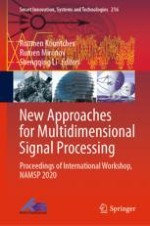This book is a collection of papers presented at the International Workshop on New Approaches for Multidimensional Signal Processing (NAMSP 2020), held at Technical University of Sofia, Sofia, Bulgaria, during 09–11 July 2020. The book covers research papers in the field of N-dimensional multicomponent image processing, multidimensional image representation and super-resolution, 3D image processing and reconstruction, MD computer vision systems, multidimensional multimedia systems, neural networks for MD image processing, data-based MD image retrieval and knowledge data mining, watermarking, hiding and encryption of MD images, MD image processing in robot systems, tensor-based data processing, 3D and multi-view visualization, forensic analysis systems for MD images and many more.
